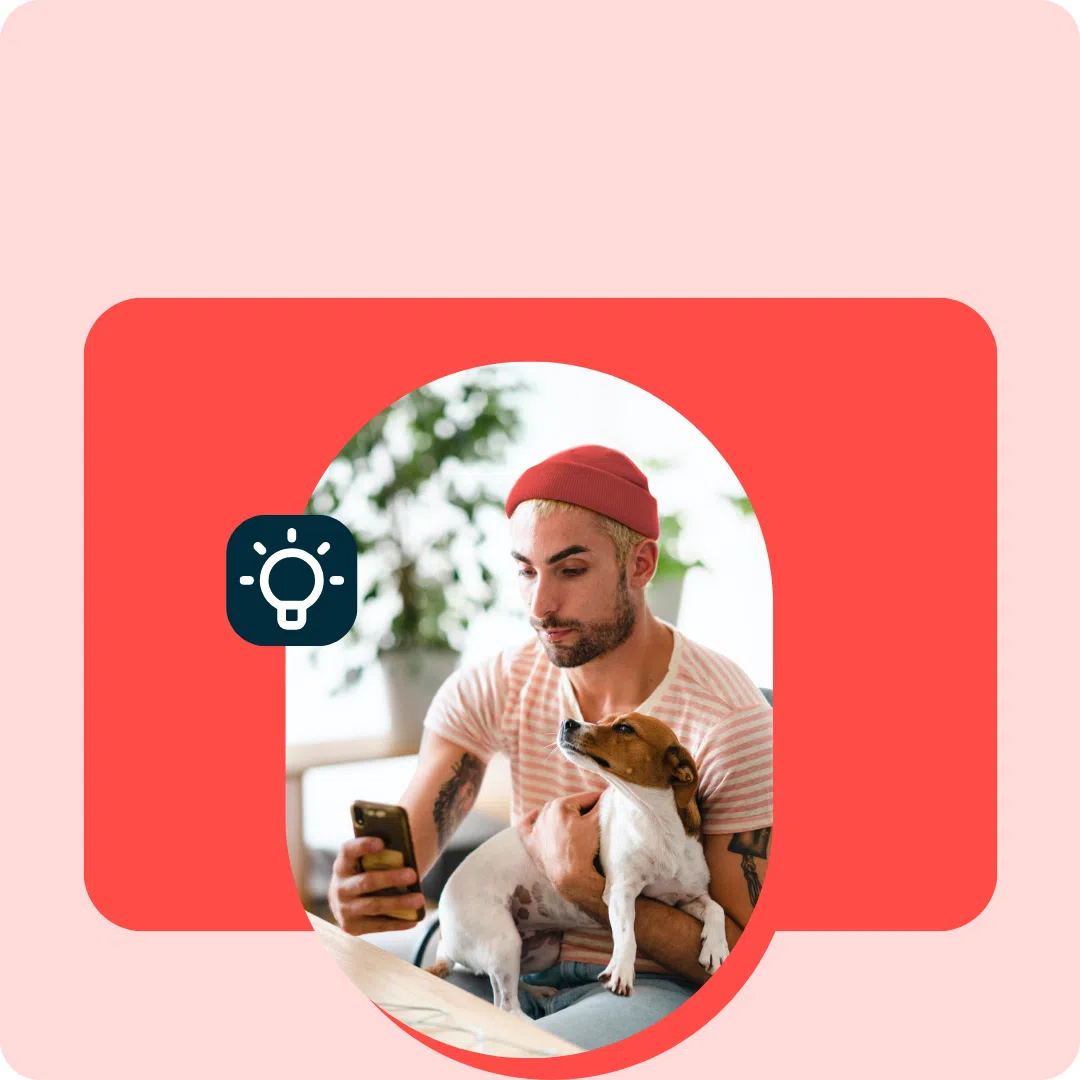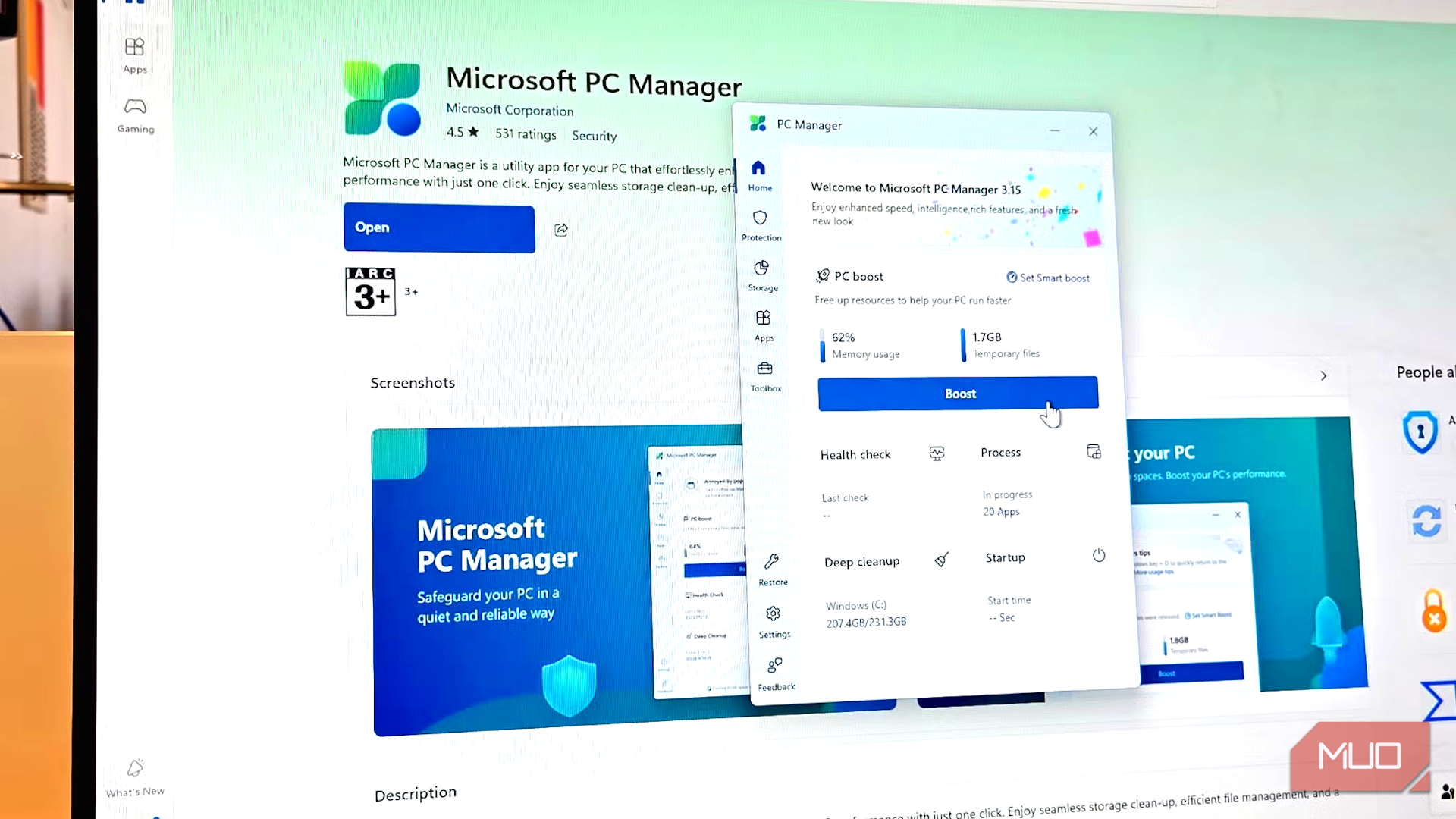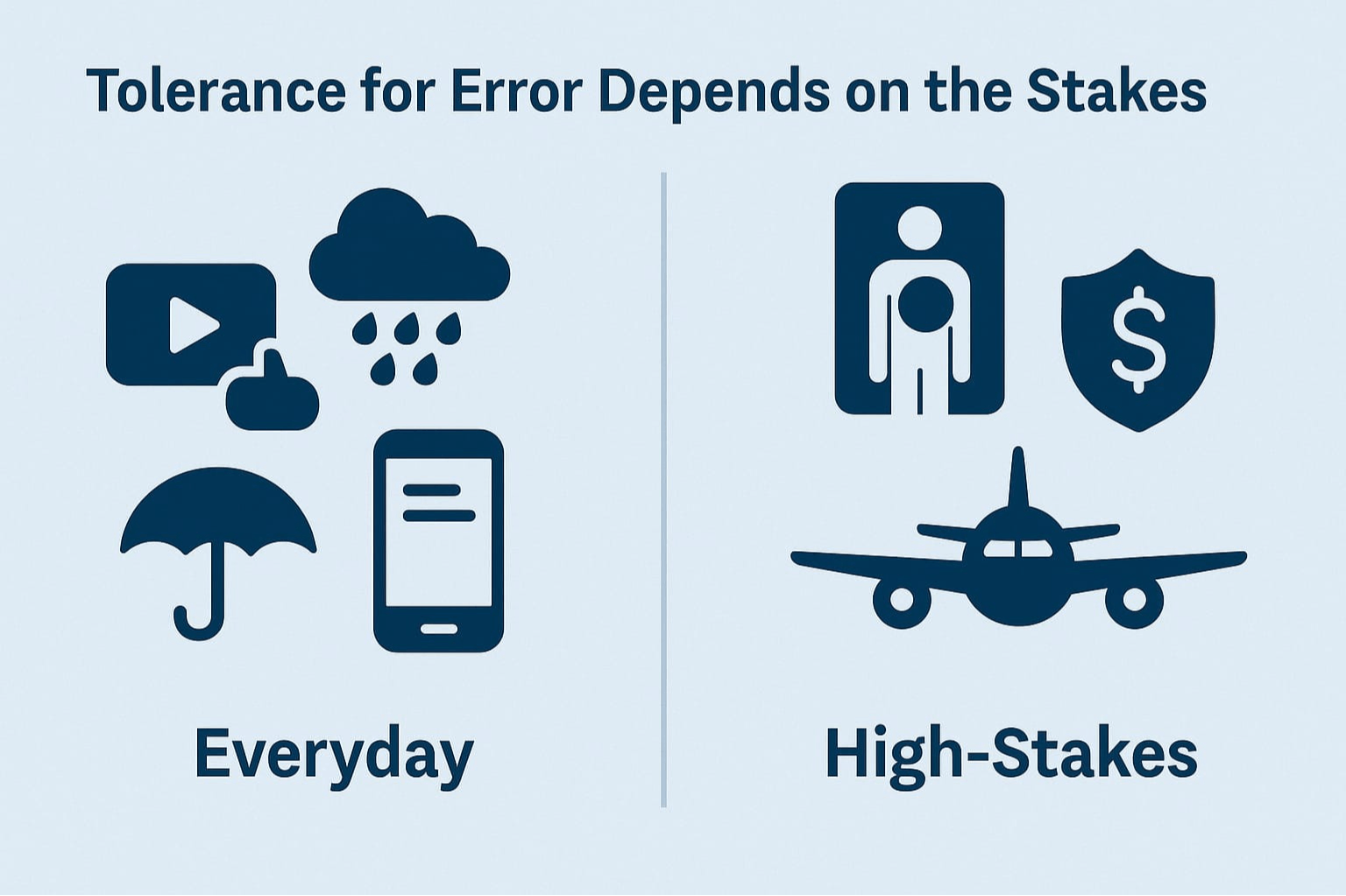There aren’t any quick fixes that will magically shoot you to the top of a social media algorithm, but there are (legitimate) ways to get the most reach possible while staying compliant with community guidelines.
Here’s the scoop on which ranking signals matter most and how you can maximize organic reach for each social media algorithm in 2025.
A social media algorithm is a collection of rules, ranking signals, and calculations that decide the content priority and display order for each user.
AI-powered social media algorithms determine what we see every time we open a social media app and use machine learning to constantly evolve and personalize the user experience.
Back in 2000, when the first social media platforms like SixDegrees, MySpace, and Facebook first emerged, algorithms were purely chronological. Users saw content from people they followed (and later, brands) from most recent to oldest.
However, as social media gained popularity, complex algorithms started curating content based on user behavior and interests. Facebook’s EdgeRank algorithm was a pioneer, first launched in 2006 and replaced in 2011 by more advanced algorithms.
And in 2025, every modern social platform ranks and displays content based on its own social media algorithms — except Bluesky, where chronological is the default. Some platforms, such as X, Facebook, and Instagram, also still offer a chronological option.
Key social media algorithm terms
Ranking signal: An attribute or factor used by social media algorithms to assess content quality and relevance. Ranking signals influence the inclusion or exclusion of content in a user’s search results or feed, and display order.
Machine learning: A component of artificial intelligence systems that can make sense of data, react, learn from, and/or act on information without needing instructions from a human. Heavily reliant on pattern recognition.
Artificial intelligence (AI): Technology enabling computers to solve complex problems, mimic human reasoning, and automate tasks traditionally done by humans.
Each platform personalizes user experience using its own set of social media algorithms, including ranking signals, machine learning models, and priorities.
Here are the most common social media algorithm ranking signals in 2025.
Engagement-based ranking
- Watch time: Important for videos, but counts for photo or text content too.
- Engagement rate: The percentage of likes, comments, and shares vs. total views.
- Share rate: Number of shares vs. total views.
- Like rate: Number of likes vs. total views.
- Comment rate: More comments = higher engagement rate but some algorithms, such as LinkedIn, also factor in discussion quality and sentiment.
Relevance and personalization
- Geolocation: Many social media platforms have location tagging features for enhanced local discovery, plus user account settings may influence content shown.
- Interests: Topics the user follows (such as hashtags on LinkedIn) as well as predictions based on recent activity.
- Previous interactions and behavior: Recent engagements (likes, comments, shares) plus the accounts a user follows help social algorithms make predictions.
- Keywords and/or hashtags: Help algorithms categorize content and match it with user interests.
- Associative relationships: How likely a user is to be interested in a piece of content or account based on similar followed accounts.
Platform goals
- Content format: Social media algorithms often prioritize newly launched formats and can change quickly to keep up with trends, like when Instagram prioritized Reels before switching to carousels.
- Ad performance: Ads are how social media platforms make money and algorithms are at the heart of ensuring they perform well.
Algorithm training
- Content quality: Subjective, based on user interests, but for algorithms it usually means if a post follows size requirements and policies.
- Trends: Algorithms learn to detect and amplify social media trends.
Here’s what you need to know about each major social algorithm to optimize content in 2025.
Overall, the top three ranking signals on Instagram in 2025 are watch time, likes, and sends, according to Head of Instagram, Adam Mosseri:
Going a little deeper, there are two types of ranking on Instagram:
- Connected reach (how you rank for people who follow you)
- Unconnected reach (how you rank for people who don’t follow you)
Each ranking type uses slightly different priorities: likes are more important for connected reach while sends are more important for unconnected reach.
The Instagram algorithm analyzes content in four stages:
- Gather posts: Instagram fetches all available posts from followed accounts, filtering out posts that violate the Community Guidelines.
- Evaluate ranking signals: Evaluates a selection of approximately 500 posts to determine relevance to the user.
- Predict value: Various machine learning models make predictions about which posts are the most valuable to each user.
- Rank content: Based on ranking signals and the AI models’ predictions, the 500 posts are scored and ranked to determine which order they show up in a user’s feed.
Each part of Instagram has its own algorithm, which follows the above workflow. These are the most important ranking signals for each.
Instagram feed algorithm
Beyond watch time, likes, and sends, these are the most important Instagram algorithm ranking signals:
- How likely a user is to click to comment, based on past commenting activity.
- How long a user will spend scrolling Reels after clicking into one. Predicted by how often a user has entered the Reels feed, how many times they watched a video with sound over the last seven days, as well as time spent with the post author’s content over the past 84 days.
- How likely a user will spend scrolling the main feed after viewing the first post. Ranking signals include device platform and how many times a user views posts that are either 1-3 days old, 8-14 days old, or 14-21 days old.
- How likely a user is to scroll to the next post. Based on previous scrolling history, as well as how other users behaved after viewing that specific post.
- How likely a user is to spend more than 10 seconds on the first post. Influenced by time spent with the post author’s content in the past, device platform, and previous view history.
Instagram Stories algorithm
For brands, it’s important to remember that Instagram Stories likely won’t fuel follower growth unless they land on the Explore page. The Stories feed only shows accounts a user already follows. The algorithm here attempts to predict which Stories users want to see first.
The most important ranking signals for the Instagram Stories algorithm are:
- How likely a user is to tap on a Story at the top of their home feed. Influenced by how often a user views Stories from a particular author and number of unseen Stories.
- How likely a user is to engage with a Story. Based on previous interaction history (likes, comments, replies) including the Story author’s content.
- How likely it is that the user is a family member or close friend of the Story’s author. At least “where data privacy laws permit.”
- How likely it is a user will swipe to the next Story or exit. Predicted by previous actions on Stories from that author and general Stories usage.
Instagram Reels algorithm
The most important Instagram Reels algorithm ranking signals are:
- How likely a user is to use the audio from the current Reel in their own. Signals include how long the user has been browsing Reels, how many times they’ve clicked on the audio link on Reels before, and used it.
- How likely a user is to watch more of a Reel than 95% of other viewers. Uses Reels of similar length to predict.
- How likely a user is to watch a Reel for less than three seconds. Influenced by how many other users watched less than three seconds.
- How likely a user is to comment or share the Reel. Predicted by previous user behavior.
Instagram Explore algorithm
The goal of the Explore page is to show each user entirely new content from accounts they don’t follow. Getting on the Instagram Explore page is the fastest way to get in front of a lot of new, hyper-targeted people.
The most important ranking signals for the Instagram Explore algorithm are:
- How likely a user is to follow an account from the Explore page. Predicted by time spent on content from that author and other accounts followed from Explore.
- How likely a user is to watch more than 95% of a video or spend more than five seconds on a post. Influenced by previous viewing history.
- How likely a user is to engage (comment, like, share, save). Signalled by previous engagement history and overall view count of the post on the Explore page.
The Facebook algorithm works across all areas of the platform, including the home feed, Stories, Reels, and Marketplace.
The Facebook algorithm uses typical behavior more than a hierarchy of most to least important ranking signals.
For example, some people hardly ever comment on posts, so commenting shows the content was very engaging to them. Others comment on everything, making it a less specific indication, so time spent per post is a better indicator of true engagement.
Of the thousands of Facebook algorithm ranking signals, these are some of the ones used most often, according to Meta:
- Facebook connections: Content chosen for users is largely from their friends, joined Groups, and liked Pages. It also includes suggested content the algorithm predicts the user will find interesting based on current connections.
- Content format: If users watch videos, they’ll see more video content in their feed or photos if they view more photos, and so on.
- Likelihood of engagement: The algorithm predicts if a user will like, comment, share, or spend more time than usual on a post.
- Relevancy: A set of predictions about how aligned a post feels to a user, determined by how likely they are to take actions like visiting a Page from a post, scroll comments, and more.
Read our article for all the details on how the Facebook algorithm works.
X (Twitter)
There are many interconnected X algorithms, but the two main ones users see are the For You and Following tabs.
Source: X
The Following feed only shows posts from accounts the user follows (plus ads). The For You tab is a mix of content from followed accounts and recommended content, based on key ranking signals such as:
- Connections: Activity by accounts the user follows, including the accounts they follow and posts they have liked.
- Previous interactions: Previous likes, comments, and shares influence what the algorithm shows in For You.
- Relevancy: Posts relating to topics the user follows and trending topics in their location.
These same ranking signals also influence content on X’s Explore page, including Trending posts, and the News, Sports and Entertainment feeds.
Read our full breakdown of the X algorithm for more details.
LinkedIn has undergone many algorithm changes over the last few years, from experimenting with video formats to ensuring content doesn’t go viral.
Known ranking signals for LinkedIn in 2025 include:
- Content quality: As a B2B platform, the overall key to LinkedIn is to produce original, valuable, expert-level content for a business audience. LinkedIn also ranks content based on time users spend on posts, professional tone, total view count, and more.
- Spam filtering: Grammatical errors, tagging individuals you’re not connected to, excessive hashtags, or posting more than once every 12 hours can trip LinkedIn’s spam flags, limiting reach.
- Recent engagement: LinkedIn determines how valuable your post is to your network within the first hour, largely based on how much meaningful engagement (comments, shares with captions, etc) it gets in that time, but continues to distribute high quality content for weeks after. The more you interact with others, the more you increase your own visibility.
- Relevancy: The people, pages, groups, hashtags, and topics a user follows and their interactions on the platform heavily influence the algorithm.
TikTok
The TikTok algorithm is the opposite of most social platforms because it prioritizes discovering new content from strangers.
Each user sees a unique For You Page (FYP) full of content ranked on these, and other, signals:
- User activity: Recent interactions, including liked, commented on, and favorited videos, accounts followed, watch time, and videos marked “Not Interested.”
- Video information: Based on recent watch history, TikTok shows similar videos based on caption keywords, audio used, hashtags, and related topics.
- Account settings: Language, location, and device type influence a user’s For You page.
- Trends: Trends are big on TikTok, in large part due to trending audio.
YouTube
Whenever a user logs in, the YouTube algorithm ranks video recommendations based on recent behavior, such as views, liked videos, and subscribed accounts.
Rather than simply promoting the most popular videos within a topic, YouTube delivers deeply personalized recommendations to keep users on the platform as long as possible.
And it works — YouTube is the second most popular social network worldwide with over 2.5 billion monthly active users.
Important YouTube algorithm ranking signals include:
- Recent activity: Video recommendations are heavily influenced by those watched during the last session, search history, and previous likes.
- What users don’t watch: If YouTube suggests videos that the user never clicks on, the algorithm will stop recommending that type of content.
- Video performance: How many views and total engagement the video has already earned from other users who watch similar content.
- YouTube SEO: The algorithm evaluates topic relevance to understand how to rank recommendations for each user, but things like titles, thumbnail images, and descriptions still factor into ranking, especially for search.
Pinterest’s advanced visual search algorithms have long been a powerful tool for marketing products, especially in visually appealing categories, such as home design, beauty, fashion, food, art, and more.
Key ranking factors when it comes to Pinterest search are:
- Visual relevance: The Pinterest algorithm is excellent at dissecting visuals and recommending similar Pins and products the user may be interested in. Recent visual search advancements include “Shop this look” which identifies and links out to products automatically.
- Trends: Based on factors like user location, search history, and recent activity. Use Pinterest’s trends tool to optimize your Pins.
- Recent saves: While all activity from search to browsing influences the Pinterest algorithm, what a user “pins” (saves) is very important.
Threads
Being a text-first platform, Threads aims to show users content that fosters discussions and engagement.
There are two main feeds in Threads: Following, for posts from accounts you follow, and For You, for a mix of content from those you follow plus suggested posts from others. (Plus, you can create custom feeds.)
In addition to posts, Threads suggests accounts to follow while scrolling.
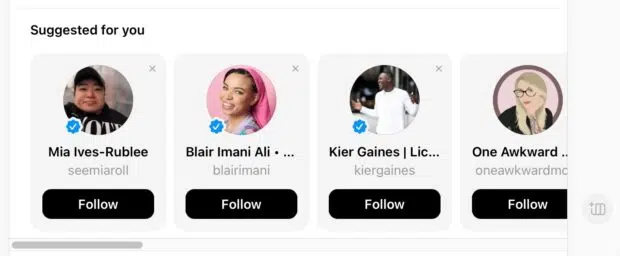
Source: Threads
Suggestions are based on mutual topic overlap, but the ownership connection between Threads and Instagram also allows for Meta to use Instagram or Facebook activity to “personalize and improve [your] Threads experience.” How much activity on one Meta platform influences the others isn’t clear.
Top Threads algorithm ranking signals include:
- How likely a user is to like, comment, or click on a post. Predicted by time spent on past posts, previous engagements over the last week, the post’s overall engagement rate, and more.
- How likely a user is to visit a post author’s profile. Influenced by time spent on Threads in the last six hours and how many profiles and posts the user previously tapped on, up to 30 days ago.
- Time spent viewing posts. Threads tracks users’ average time spent on each post over the past 84 days, including view time by media format for the past 30 days.
Bluesky
Bluesky breaks the norms of how social media algorithms work by having a chronological post feed from only accounts the user follows as the default setting in the Following tab. The Discover tab is a mix of suggested content and posts from followed accounts.
Being an open-source platform, users have more control over their data and content preferences on Bluesky than on other networks. Bluesky is committed to the idea of “algorithmic choice,” where users aren’t subjected to one algorithm, but free to create and curate multiple algorithms to match their interests.
There are over 50,000 custom algorithmic feeds users can subscribe to, and anyone can create one.
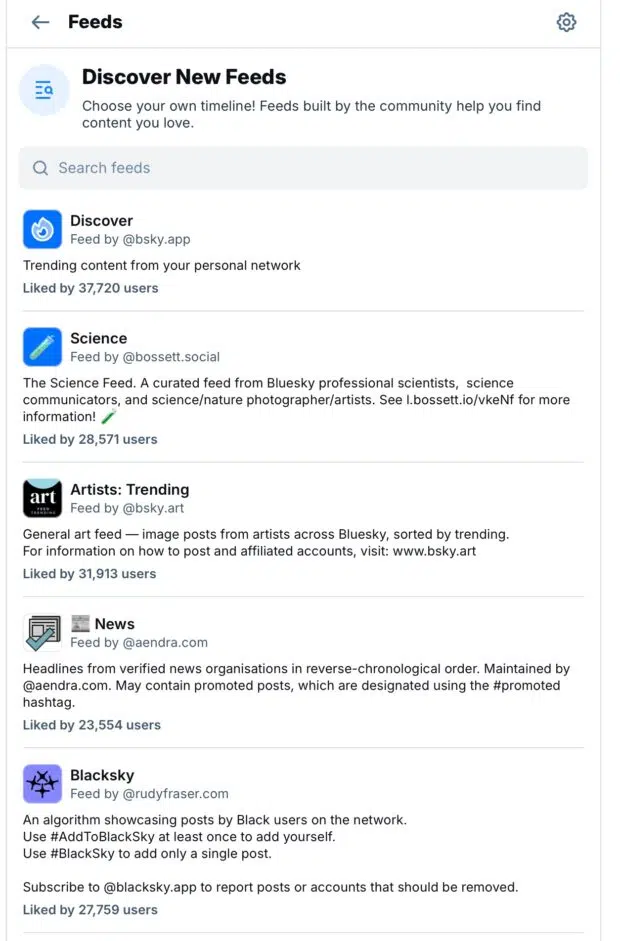
Source: Bluesky
Since users have so much control over their Bluesky algorithms, ranking signals won’t work the same for everyone. What matters most on Bluesky is relevancy and community connection.
To grow on Bluesky, brands should:
- Get involved with or create niche communities by making custom feeds for your industry or topic.
- Create a starter pack of employees and high-value posts to help people find and interact with you.

Source: Canadian Content Starter Pack on Bluesky
- Experiment with content that connects. Marketers report the best success on Bluesky from testing new concepts before taking what they learn to other platforms. (Get more expert tips in our guide to using Bluesky for business!)
Callout box: What changed in 2024–2025?
- Text-first content is making a comeback with popularity of Threads, X, and Bluesky. Brands should factor in experimenting with these platforms leading into 2026.
- Bluesky is now a major player with over 38 million users.
- Influencer marketing spend is expected to surpass both social and digital ad spend for the first time in 2025.
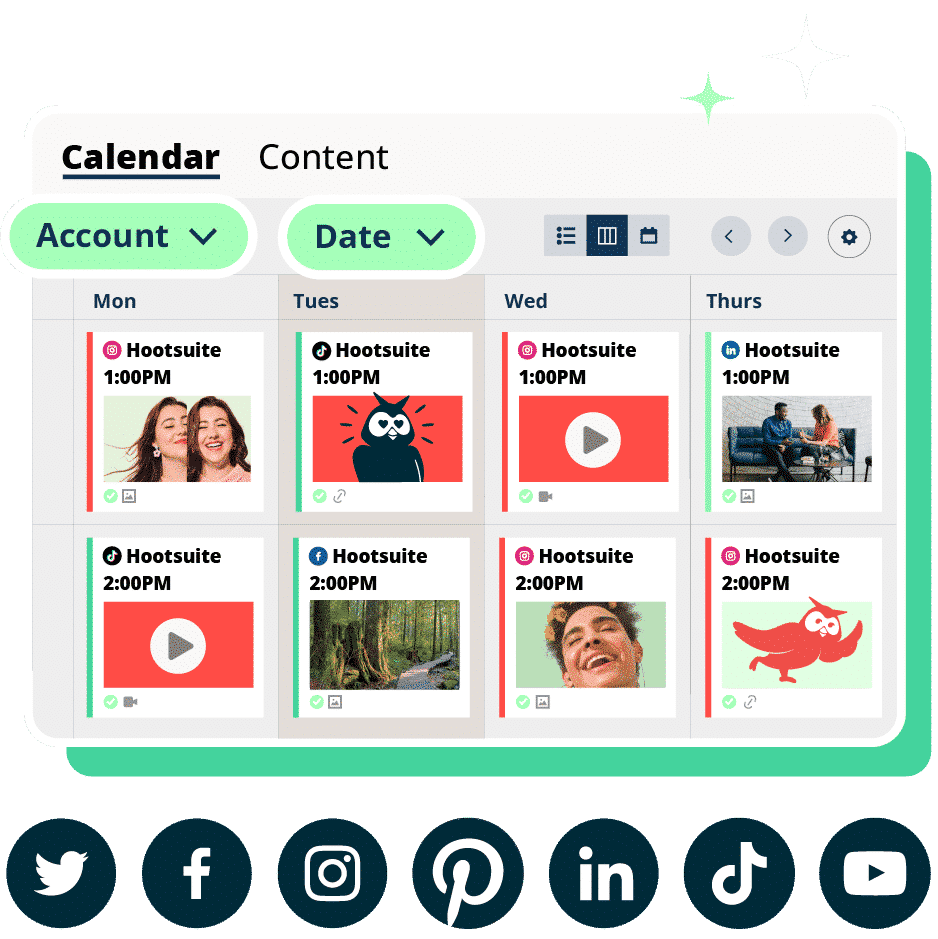
#1 Social Media Tool
Create. Schedule. Publish. Engage. Measure. Win.
Free 30-Day Trial
Social media algorithms are often blamed for shortening our attention spans (though, research is inconclusive), spreading misinformation, and causing negative mental health impacts in youth.
Without algorithms, our social media experiences would lack the quick access to like-minded communities that can foster positive discussions and connections with people around the world.
On the other hand, researchers have observed how social algorithms can trap users in an echo chamber “. . . where digital platforms not only disseminate but also intensify radical ideologies. . . . This environment allows individuals to connect over shared extremist views without encountering dissenting opinions, thereby reinforcing a narrow worldview.”
Ultimately, we as human beings need to use algorithms wisely to connect us with the content we want while also remembering we have free will to seek out contrarian views and fact-checking resources.
Love ‘em or hate ‘em, social media algorithms are here to stay. Here’s why brands and creators need to stay on their “nice lists.”
Impact on reach and engagement
Maximizing your organic reach is a direct result of how well you optimize content for algorithms. The reach you get also impacts engagement; no one can like, comment, or share unless they see the post first.
Social SEO
Social SEO can involve using the right keywords in post captions, but more often than not, it’s about creating content that the algorithm understands so it can show it to the right audience.
Social search is increasingly important as 46% of Gen Z use social media instead of Google for searching, and 44% use social media to discover new brands.
The importance of consistency and quality
Follow brand guidelines, use the right colors and logos, and post with a regular cadence… but leave room for experimentation.
Right now, almost half of brands are focusing on entertaining content without being self-promotional because it works.
Our research finds that brands that regularly get creative on social — not unhinged, just different from most — are more likely to see positive business impacts from social media.
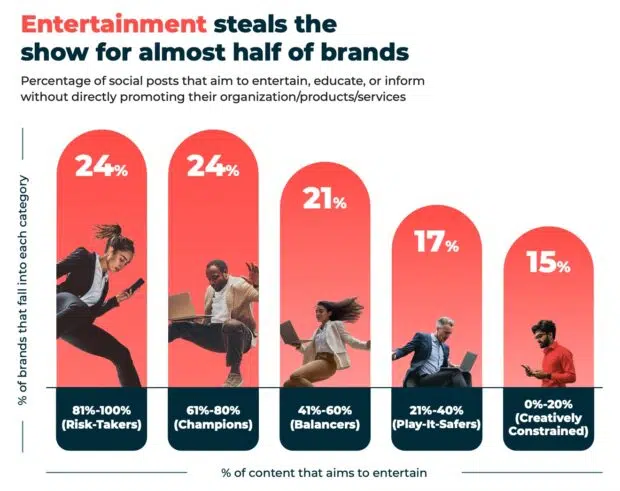
As for how often to post, these are the averages for top platforms in 2025:
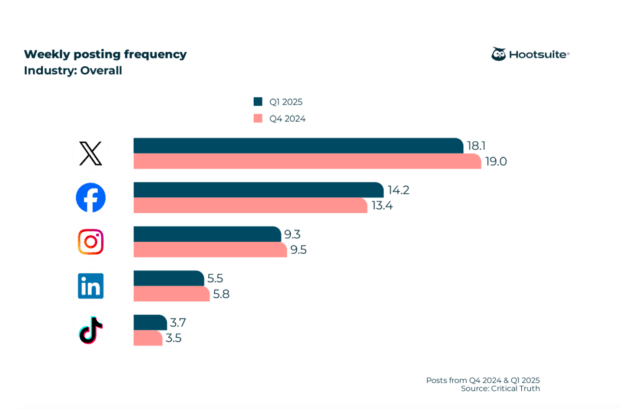
Check out our full breakdown by platform, industry, and more in our guide to how often to post on social in 2025.
Engagement is everything
Engagement is more than a numbers game. Meaningful engagement attracts new customers, converts leads, and builds trust. Plus, engagement is a major signal to social media algorithms that your content is worth promoting.
What counts as a “good” level of engagement varies across platforms and industries. Find your target in our full report of engagement rate benchmarks for 14 industries, or use these as a general goal.
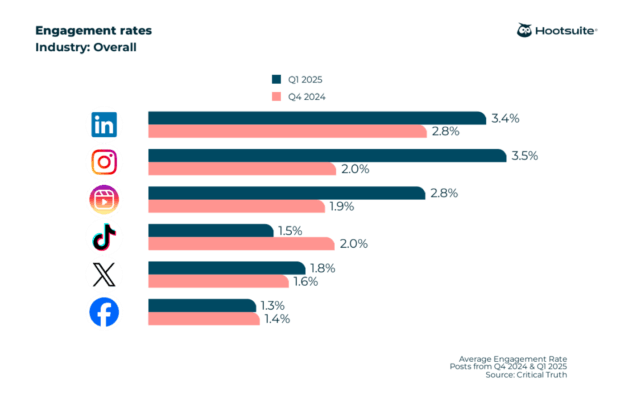
Social algorithms are always changing. What’s next?
Go text-first?
We’ve noticed brands flocking to Threads, X, and Bluesky to experiment with brand voice and build authentic discussion spaces. Is text-first content right for your organization? It’s a good time to revisit your social media strategy to ensure the platforms you’re on align with your goals.
An em dash means it’s AI content
OK, not really. People are over the “spot the AI” hype and instead are focusing on the message behind your content.
Whether you use Hootsuite’s OwlyWriter AI to create content and repurpose your top posts in minutes or other AI social media tools, there are plenty of ways to save time without sacrificing quality.
Social media is not a megaphone
Algorithms are increasingly relying on engagement as an indicator of content quality.
Brands who incorporate outbound relationship building by leaving comments on others’ posts will reap the rewards of more promotion. The key is choosing the right creators to comment on: when the account author replies to a brand comment, brands earn 1.6X more engagement.
Make all the social media algorithms happy and save time by scheduling and publishing content, engaging your audience, and measuring performance across all your profiles from a single dashboard with Hootsuite. Try it free today.

